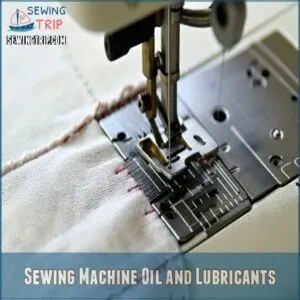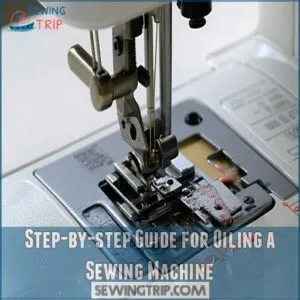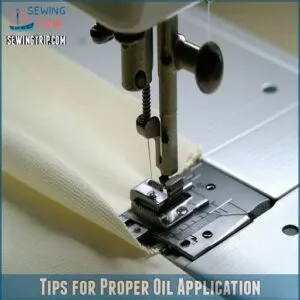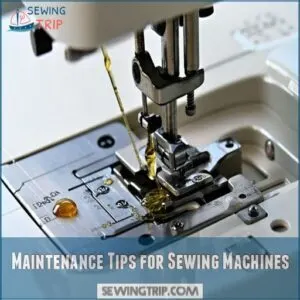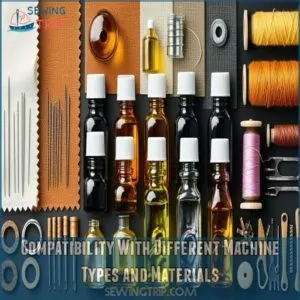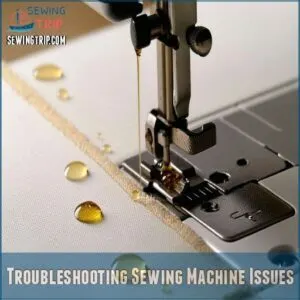This site is supported by our readers. We may earn a commission, at no cost to you, if you purchase through links.
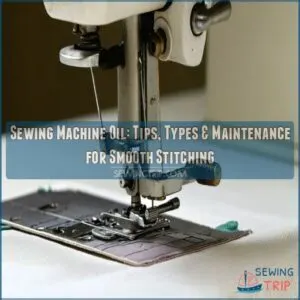 Want your sewing machine to purr like a well-oiled machine? Sewing machine oil is your secret weapon for smooth stitching.
Want your sewing machine to purr like a well-oiled machine? Sewing machine oil is your secret weapon for smooth stitching.
It’s a specialized lubricant that reduces friction between moving parts, preventing wear and tear.
Choose between mineral or synthetic oils based on your machine’s needs—they’ll keep your gears gliding and needles dancing.
Apply sparingly with a clean cotton swab, targeting key spots like the needle bar and hook race. Don’t go overboard; a little goes a long way. Wipe away excess oil to avoid fabric stains.
Regular oiling isn’t just maintenance—it’s your machine’s fountain of youth, ensuring it keeps humming along for years to come.
Table Of Contents
Key Takeaways
- You’ll protect your sewing machine’s longevity by using specialized sewing machine oil, which reduces friction between moving parts and prevents costly wear and tear.
- Don’t use household oils like WD-40 or olive oil; instead, choose mineral or synthetic oils specifically designed for sewing machines to ensure smooth operation and prevent damage.
- You’ll want to oil your machine sparingly, targeting key spots like the needle bar and hook race, with frequency depending on your usage (typically every 8 hours of continuous use or weekly).
- Regular maintenance isn’t just about lubrication—you’ll need to clean out lint, check tension, and perform routine checks to keep your machine running at peak performance and avoid potential mechanical issues.
Sewing Machine Oil and Lubricants
You can’t underestimate the importance of the right sewing machine oil or lubricant—it’s what keeps your machine running smoothly and prevents costly wear.
With so many options available, choosing the right type means avoiding common mistakes, like using household oils, and sticking with products made specifically for sewing machines.
sewing machine oil is important.
Types of Sewing Machine Oil
In the context of sewing machine oil types, you’ve got mineral oil and synthetic oils leading the pack.
Mineral oil, a budget choice, resists oxidation and stays stable.
Synthetic oils, made from chemicals, handle extreme temperatures like a pro while offering smoother lubrication.
Choosing the best sewing machine oil means balancing oil viscosity, safety, and performance needs.
Benefits of Using Sewing Machine Oil
With sewing machine oil, you’ll gain access to a world of smooth, efficient crafting that keeps your trusty machine purring like a well-oiled (literally!) companion. Imagine extending your machine’s life while preventing rust and reducing friction – all with a simple maintenance step.
Here’s why sewing machine oil is your secret weapon:
- Eliminates friction between moving parts
- Creates a protective barrier against moisture
- Reduces annoying mechanical noises
- Boosts overall machine performance
- Prevents costly future repairs
By investing just a little time in lubrication, you’ll be able to rely on your sewing machine to deliver precise, professional-quality stitches every single time. Your crafting freedom starts with proper maintenance.
Alternatives to Sewing Machine Oil
Every seasoned sewist knows that finding the right lubricant can be a game-changer for your machine’s performance. While specialized sewing machine oil reigns supreme, you’ve got some intriguing alternatives to explore. Household lubricants like petroleum jelly and silicone spray work wonders for light-duty tasks, offering quick fixes in a pinch.
Regular maintenance and troubleshooting are key to keeping your machine, including overlock machine components, running smoothly.
Industrial-grade mineral and synthetic lubricants pack a punch for heavy-duty tasks, delivering robust protection against wear and heat.
| Lubricant | Application | Benefits | Considerations |
|---|---|---|---|
| Household Lubricants | Light-duty machinery | Easily accessible | Limited effectiveness |
| Industrial Lubricants | Heavy machinery | High wear resistance | Specialized application |
| Automotive Lubricants | Engine components | Temperature resilient | Machine compatibility |
| Metalworking Lubricants | Precision operations | Cooling properties | Disposal challenges |
Pro tip: Always test alternatives cautiously to prevent potential damage to your beloved sewing companion.
How to Apply Sewing Machine Oil
You’ll want to treat your sewing machine to a smooth performance with proper oiling, ensuring its longevity and precision.
By learning the right techniques for applying sewing machine oil, you’ll keep your trusty companion running like a well-oiled dream.
preventing wear and maintaining the highest stitching quality.
Step-by-step Guide for Oiling a Sewing Machine
Master your sewing machine’s performance with a precise oiling routine that’ll keep your stitches smooth and your machine purring.
Before diving in, grab these essentials:
- High-quality sewing machine oil
- Clean cotton swabs or tiny brush
- Your machine’s trusty manual
Unplug your machine and carefully remove the needle plate. Locate key moving parts like the needle bar and thread mechanisms. Apply a few drops of oil sparingly, wiping away any excess to prevent fabric staining. Your machine will thank you with years of reliable service.
Areas of The Machine That Require Oiling
Maximize your sewing machine’s potential by targeting key lubrication zones that keep it humming smoothly. Different parts of your machine crave specific attention to prevent wear and maintain peak performance.
It’s vital to maintain a clean and organized workspace and follow manufacturer’s guidelines for machine maintenance.
Check out this quick reference guide for critical oiling points:
| Area to Oil | Importance | Lubrication Benefit |
|---|---|---|
| Bobbin Case | High | Facilitates smooth thread movement |
| Needle Bar | Critical | Prevents rust, reduces friction |
| Hook Race | High | Protects precision mechanisms |
| Feed Dog | Important | Maintains consistent fabric movement |
| Gear Teeth | Key | Reduces mechanical wear |
Tips for Proper Oil Application
With precision and care, apply sewing machine oil to keep your trusty companion running smoothly. Targeted lubrication is your secret weapon for machine longevity and performance. Consider investing in a high-quality sewing machine oil applicator to make the process easier.
- Feel the satisfaction of a well-maintained machine
- Prevent fabric snags and thread breaks
- Extend the life of your sewing investment
Minimize excess oil by using a fine-tipped applicator. Clean any spills immediately to protect your machine’s delicate mechanisms. Remember: a little oil goes a long way in sewing machine maintenance.
Maintenance Tips for Sewing Machines
Your sewing machine is more than just a tool; it’s an investment that needs regular care to keep running smoothly.
By following key maintenance tips and understanding the importance of proper cleaning and oiling,
you’ll guarantee your machine continues to stitch perfectly and avoid costly repairs down the line.
Importance of Regular Cleaning and Oiling
After carefully lubricating your machine’s moving parts, you’ll want to keep it in top shape through regular cleaning and maintenance.
Your sewing machine is more than just a tool—it’s your creative partner that needs consistent care.
Here’s a quick guide to keeping your machine humming along smoothly:
| Frequency | Cleaning Method | Maintenance Impact |
|---|---|---|
| Weekly | Lint brush | Prevents buildup |
| Monthly | Compressed air | Removes deep debris |
| Every 8 hours | Soft cloth | Reduces friction |
| Before projects | Thorough check | Guarantees smooth operation |
| Annually | Professional service | Extends machine lifespan |
Preventing rust and guaranteeing smooth operation isn’t rocket science—it’s about showing your machine some love.
Common Issues Caused by Lack of Maintenance
Ever wondered why your trusty sewing machine suddenly sounds like a rusty old tractor? Neglecting maintenance can turn your creative haven into a repair nightmare.
Unchecked wear and tear can wreak havoc on your machine’s performance: Regular use necessitates sewing machine oil to keep it running smoothly.
- Skipped stitches compromise your project’s quality
- Noisy operation disrupts your creative rhythm
- Broken parts lead to costly repairs
- Sluggish movement kills your creative momentum
Without regular sewing machine lubrication, you’re basically running your machine into the ground. Each missed maintenance session is like driving a car without oil – it’s a recipe for disaster that’ll leave your machine gasping for care and your projects hanging by a thread.
Best Practices for Maintaining a Sewing Machine
Want to keep your sewing machine purring like a well-oiled machine? Regular preventative maintenance is your secret weapon.
Clean the bobbin area religiously, ensuring lint doesn’t crash your creative party.
Check thread tension, swap out dull needles, and adjust foot pressure based on fabric weight.
These sewing machine lubrication and care tips will help you dodge costly repairs and keep your trusty companion stitching smoothly for years to come.
Choosing The Right Sewing Machine Oil
You’ll want to choose your sewing machine oil carefully to keep your machine running smoothly and prevent costly damage.
With the right oil, you’ll extend your machine’s life, reduce friction, and guarantee those stitches stay precise and perfect. sewing machine oil costly damage
Factors to Consider When Selecting Sewing Machine Oil
When diving into sewing machine oil selection, you’ll want to take several key factors into account that keep your machine purring like a well-oiled kitten. Your choice impacts performance and longevity, so pay attention to these details:
- Match oil viscosity to your machine’s specific requirements
- Research brand reputations for quality and longevity
- Consider the environmental impact of your chosen lubricant
Compatibility With Different Machine Types and Materials
Like a tailor’s perfect stitch, choosing the right sewing machine oil demands precision.
Your machine’s sensitivity to oil viscosity can make or break its performance.
Different models—from delicate home machines to industrial workhorses—require specific lubricant types.
Consider material safety, brand compatibility, and potential oil degradation.
Don’t just grab any bottle; match the oil to your machine’s unique personality. The right lubricant guarantees smooth operation, preventing wear and extending your sewing companion’s lifespan. smooth operation, preventing wear, extending your sewing companion’s lifespan.
Recommendations for Specific Brands or Types of Oil
After matching your machine’s needs, picking the right sewing machine oil becomes an art form.
Here’s your roadmap to lubricant mastery:
- Survey synthetic vs. mineral options
- Evaluate brand reputation carefully
- Check viscosity requirements
- Research eco-friendly alternatives
Your machine’s performance depends on this critical selection process.
Troubleshooting Sewing Machine Issues
When your sewing machine starts acting up, don’t panic—proper oiling might be the quick fix you need.
Understanding the common issues and how lubrication can resolve them will help you keep your machine running smoothly.
prevent costly repairs.
How Sewing Machine Oil Can Help Resolve Common Problems
Here’s the improved subtopic content:
Struggling with a squeaky, temperamental sewing machine? Sewing machine oil is your secret weapon for smooth sailing.
By lubricating key components, you’ll silence annoying machine noises and boost performance.
Reducing friction means fewer stitch issues and a longer machine life.
Whether you’re working with a vintage workhorse or a modern marvel, the right oil transforms your sewing experience from frustrating to fantastic. Think of it as a little TLC for your trusty crafting companion.
When to Seek Professional Assistance
When mechanical gremlins start sabotaging your sewing project, professional help becomes your secret weapon. Knowing when to wave the white flag can save your machine—and your sanity.
Consider professional assistance when:
- Major repairs threaten to overwhelm your DIY skills
- Unusual noises signal deeper mechanical problems
- Warranty concerns demand expert intervention
A professional sewing machine repair shop provides more than just a quick fix. They diagnose complex issues with surgical precision, offering targeted solutions that preserve your machine’s performance and extend its lifespan. Trust the experts when your machine’s health hangs in the balance—it’s an investment in your crafting future.
Other Maintenance Techniques for Optimal Machine Performance
Release your sewing machine’s full potential with four killer maintenance techniques that’ll turn your machine into a precision instrument:
- Examine the bobbin area closely, adjusting tension settings to silence those pesky performance gremlins.
- Pamper vintage machines with gentle, regular oiling that shows sweet longevity to their mechanical hearts.
- Explore eco-friendly lubricants that show Mother Nature some serious sewing machine love.
- Get experimental with unconventional lubricants like white lithium grease, treating your machine like the performance beast it is.
Your creativity deserves a finely-tuned companion.
Frequently Asked Questions (FAQs)
What kind of oil do you use for a sewing machine?
A stitch in time saves nine!
Choose specialized sewing machine oil like refined mineral or synthetic variants.
Avoid WD-40, cooking oils, or generic lubricants. Always consult your machine’s manual for brand-specific recommendations to keep your stitching smooth.
Can I use WD-40 instead of sewing machine oil?
No, don’t use WD-40 on your sewing machine!
It’ll damage internal parts and gum up the mechanisms.
Stick to specialized sewing machine oil for smooth operation and to protect your valuable machine’s delicate components.
Is 3 in 1 oil ok for sewing machines?
Skip the 3-in-1 oil for your sewing machine.
It’ll gum up the works and damage delicate parts faster than you can say "stitch gone wrong."
Stick to specialized sewing machine oil for smooth, happy stitching.
Can I oil my own sewing machine?
Yes, you can oil your own sewing machine!
Just grab sewing machine-specific oil, and follow your manual’s guidance.
Clean out lint first.
Apply tiny drops to moving parts.
It’s easier than you might think.
Can I use olive oil on my sewing machine?
While olive oil’s kitchen charm might tempt you, don’t let it near your sewing machine.
Cooking oils degrade quickly, attract lint, and can damage delicate mechanisms.
Stick to specialized sewing machine oil for smooth, long-lasting performance.
How often should beginners oil their machines?
You’ll want to oil your sewing machine every 8 hours of continuous use or weekly if you’re sewing 2-4 times a week.
Always check your manual first.
clean out lint before lubricating your trusty stitching companion.
What happens if I dont oil?
Neglecting to oil your sewing machine leads to increased friction, accelerated wear, potential rust, and eventual component failure.
Without proper lubrication, your machine’s moving parts grind against each other, causing irreversible damage and costly repairs.
This leads to irreversible damage.
Are vintage sewing machines harder to lubricate?
Vintage sewing machines often demand more elbow grease for lubrication.
Their intricate, older mechanisms require careful disassembly, specialized oils, and patience.
Consulting original manuals or vintage machine experts can help you navigate these mechanical treasures’ unique maintenance needs.
Does sewing machine oil expire or go bad?
Time flies, and so can sewing machine oil!
Most oils last 2-3 years if stored properly.
Keep your bottle sealed, away from heat and sunlight.
Check for color changes or strange smells – these signal it’s time to replace your lubricant. This is a crucial step for maintaining your sewing machine.
Conclusion
Like a trusted mechanic tuning up your favorite ride, sewing machine oil keeps your trusty stitching companion running smoothly.
You’ll extend your machine’s life and prevent costly repairs by understanding its lubrication needs.
Regular maintenance with the right sewing machine oil isn’t just a chore—it’s an investment in your craft.
Whether you’re a hobbyist or professional, a few drops of carefully applied oil can make all the difference in your sewing journey.

